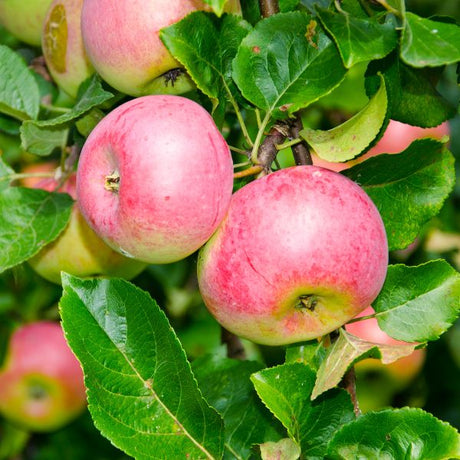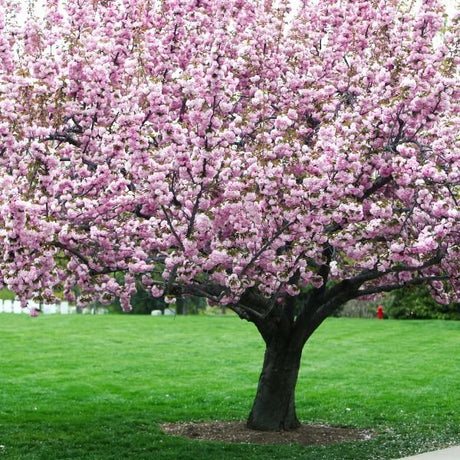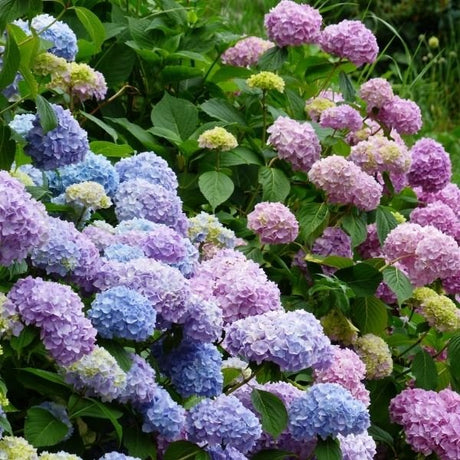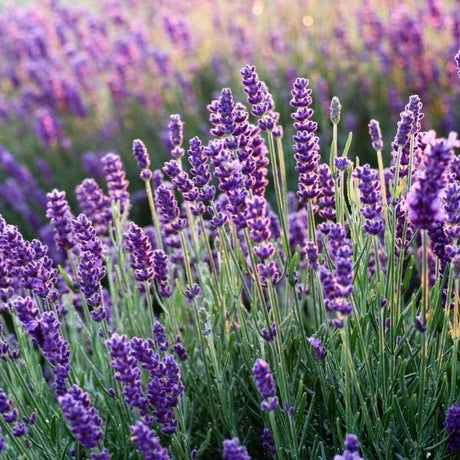Prairie Magic® Apple
Malus x 'Jefdale'
- Stay Protected with Plant Sentry ™
Prairie Magic® Apple - 4-5 Feet Bareroot Standard Height is backordered and will ship as soon as it is back in stock.
Plant Sentry™
Plant Sentry™
Plant Sentry is designed to protect both consumers and the nursery trade from invasive plant pests and diseases. Sites that display the Plant Sentry protection badge are protected from consumers buying and nurseries shipping material carrying invasive pests and diseases.
This proprietary eCommerce software prevents the shipment of a restricted plant to each state. The Plant Sentry system includes a shipment certification program. The Plant Sentry Compliance Officer works closely with NatureHills.com and each nursery or fulfillment center to ensure only compliant plants are sold to customers.
Click Here to learn more

Delivery and Shipping
Delivery and Shipping
Shipping
To obtain a more accurate shipment time-frame, simply enter your zip code in the “Find Your Growing Zone” box to the right. Our plants are grown all over the country and lead time on items may be different because of this. Once your order is placed, you will also receive the specific shipment time-frame information as part of your order confirmation. Once an item ships, you will receive shipment notification and tracking numbers, so you can follow along while your plant travels to your doorstep. We use FedEx, UPS, or USPS at our discretion.
Due to winter weather we have put a hold on shipping to the areas shown below in grey. You can still order now and we will ship the plant to you during an appropriate time for your zone.
Standard Shipping Rates
At Nature Hills we handle, package and ship the products you order with the utmost care to ensure healthy delivery. Shipping and handling charges are calculated based on the tables below. Please note that some items include an additional handling surcharge, these will be noted on the item's product page.
| From | To | S&H |
|---|---|---|
| $0 | $19.99 | $24.99 |
| $20 | $49.99 | $29.99 |
| $50 | $69.99 | $34.99 |
| $70 | $99.99 | $39.99 |
| $100 | $129.99 | $44.99 |
| $130 | $149.99 | $48.99 |
| $150 | $150+ | Approx 28% |
Click here to see our full rates
Understanding Plant Options
Nature Hills offers plants in two main formats:
- Container Plants: Grown in pots with soil, sized by container volume and plant age
- Bare Root Plants: Dormant plants without soil, sized by height measurements
Container Plant Sizes
Container sizes indicate plant age and growing capacity rather than liquid volume equivalents. Our containers follow industry-standard nursery "trade gallon" specifications, which differ from standard liquid gallon measurements.
Young Plants (6 months to 18 months old)
| Container Size | Actual Volume | Metric Equivalent |
|---|---|---|
| 2" x 2" x 3" | 0.18 - 0.21 dry quarts | 0.20 - 0.23 dry liters |
| 4" Container | 0.31 - 0.87 dry quarts | 0.35 - 0.96 dry liters |
| 4.5" Container | 0.65 dry quarts | 0.72 dry liters |
| 6" Container | 1.4 dry quarts | 1.59 dry liters |
| 1 Quart | 1 dry quart | 1.1 dry liters |
| 5.5" Container | 1.89 dry quarts | 2.08 dry liters |
Established Plants (18 months to 2.5 years old)
| Container Size | Actual Volume | Metric Equivalent |
|---|---|---|
| 2 Quart | 2 dry quarts | 2.2 dry liters |
| #1 Container | 2.26 - 3.73 dry quarts | 2.49 - 4.11 dry liters |
| 5" x 5" x 12" | 3.5 - 4.3 dry quarts | 3.85 - 4.74 dry liters |
Mature Plants (2-4 years old)
| Container Size | Actual Volume | Metric Equivalent |
|---|---|---|
| #2 Container | 1.19 - 1.76 dry gallons | 5.24 - 7.75 dry liters |
| #3 Container | 2.15 - 2.76 dry gallons | 8.14 - 12.16 dry liters |
Large Plants (3-5 years old)
| Container Size | Actual Volume | Metric Equivalent |
|---|---|---|
| #5 Container | 2.92 - 4.62 dry gallons | 12.86 - 20.35 dry liters |
| #6 Container | 5.25 - 6.01 dry gallons | 23.12 - 26.42 dry liters |
| #7 Container | 5.98 - 6.53 dry gallons | 26.34 - 28.76 dry liters |
Bare Root Plants
Bare root plants are sold by height from the root system to the top of the plant. Plants may exceed minimum height requirements.
Common Sizes:
- Trees: 1 foot, 2 feet, 3 feet, 4 feet, 5 feet, 6 feet
- Shrubs & Perennials: 1 foot, 18 inches, 2 feet
Important Notes
Container Volume Specifications
- Trade Gallon Standard: Our containers follow industry-standard "trade gallon" specifications established by the American National Standards Institute (ANSI Z60.1) for nursery stock
- Volume Variations: Actual soil volume may vary due to plant root systems and growing medium settlement
- Age Indicators: Container size primarily indicates plant age and maturity rather than liquid volume equivalents
Growing Conditions
- Plant size can vary based on variety and growing conditions
- Container size helps indicate plant maturity and establishment level
- Larger containers generally mean more established root systems and faster landscape establishment
Seasonal Availability
- Bare root plants are available seasonally when dormant
- Container plants are available throughout the growing season
- Specific varieties may have limited availability in certain sizes
Questions?
For questions about specific plant sizes or availability, please contact our plant experts who can help you choose the right size for your landscape needs.
Plant Highlights
Prairie Magic® Apple highlights at a glance!
Specifications
Specifications
-
Botanical Name
-
Growing Zones
-
Mature Height
-
Mature Spread
-
Sun ExposureFull Sun
-
Moisture
-
Soil
-
Growth RateMedium
-
Flower Color
-
Fall Color
-
Pollinator Friendly
-
Pollinator Required
-
Fragrant
-
Pruning Time
-
Bloom PeriodEarly Spring, Late Spring
-
Harvest Time
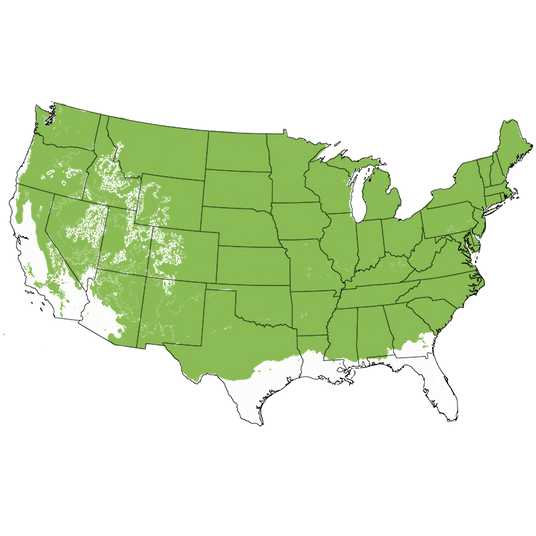
Growing Zones 3 - 8
Apples so sweet you can eat them before they're completely ripe? Sounds like magic! The Prairie Magic® Apple (Malus x 'Jefdale') really is just what the impatient gardener needs in their orchard! Super hardy introduction from Canada with medium-large green fruit with red blush.
Spring brings scented white blossoms and the bees and butterflies go mad for these nectar and pollen-rich blooms! Prairie Magic® Apples are especially good for fresh eating but also hold up for cooking and baking too! The crispy flesh is white and very sweet!
A cross between the Goodland and Mantet Apple varieties, Prairie Magic® is hardy throughout USDA growing zones 3 to 8. These semi-dwarf trees grow to a semi-dwarf size under 15 feet in height and width. This tree is not self-pollinating and does need a pollination partner for the best harvest. Try pairing with another tree that blooms at the same time for a large yield. No room? Prune smaller or check out high-density planting techniques.
Planting and Application:
These semi-dwarf trees readily tuck into existing orchards or established landscapes with ease and can be pruned smaller yet to accommodate smaller yards and to allow smaller properties to accommodate Prairie Magic's® pollinator tree. Make your front yard a double-duty orchard with these flowering trees, or create linear orchards by using your Apple trees as part of a larger fruiting hedgerow!
Prairie Magic® Apple is as pretty as its fruit is flavorful! Plant this shade-producing specimen anywhere on your property or as a garden bed anchor that provides shade for your perennials. So kick back and read a book beneath the buzzing bees in spring or fall while watching your harvest ripen!
- Green Apples With A Red Blush
- Super Sweet, Crisp White Flesh
- Large Sweet & Abundant Apples
- Ripen Late August til September
- Fragrant White Flowers
- Fantastic For Fresh Eating, Cooking & Baking
#ProPlantTips for Care:
How do you grow Apple Trees? Easy to grow, these fruit trees require full sun and well-drained soil to do their best. Fruit trees do not tolerate excess water or poor drainage as they cannot have soggy soil. Plant in rich, organically amended soil, plus a good layer of mulch over the root system's surface to further hold in moisture and insulate the roots from heat and cold. Apples need consistent watering, especially during summer for higher yields. It's best to protect your investment with a regular watering schedule during times of need.
Because it's such a heavy-producing tree, part of Apple tree care is to thin out the fruit in the spring. Branches can break under the weight of all that beautiful fruit. Pruning is best done in late winter when the tree is dormant in the late winter or very early spring. Prune to keep an open canopy that allows plenty of sunshine and air circulation.
- Full Sun Trees
- Enriched Well-Drained Soil
- Regular Water & Appreciates Mulch
- Prune When Dormant
- Moderate Resistance to Apple Scab
- 700-800 Chill Hour Needs
Honeygold Apple Trees are your answer for a cold-hardy golden Apple that won't take up a lot of space! Order quality plants with mature root systems to your doorstep from Nature Hills Nursery!
Prairie Magic® Apple Tree Frequently Asked Questions
When to Plant Apple Trees?
Planting Bareroot trees as soon as you can dig a hole in spring and until hot weather, the earlier the better. Plant container Apple trees throughout the growing season with complete success - that is the benefit of container plants - to extend the planting season. Your County Agricultural Extension Office is a great resource for first and last frost dates in your area.
How to Plant Prairie Magic® Apple Trees
Dig a large hole only as deep as needed to accommodate the bareroot or container root ball, and twice as wide. Add Nature Hills Root Booster to speed root establishment. Remove the pot or bag and situate it into the hole so the top of the soil (soil line if bareroot), is level with the new location's soil being careful not to plant too deep. Water in again very well and backfill with the same soil you dug up, tamping down gently to ensure there are no air pockets.
Top off with a 3-4 inch thick layer of Arborist mulch. Consider staking your tree to keep its trunk growing straight for the first year to ensure it stands tall against strong winds and drifting snow.
When to Prune Prairie Magic® Apple Trees
Trim off any broken branches from delivery as soon as you take them out of the box. Prune and trim Apple trees while dormant, in late winter or early spring, before you see new growth.
How to Prune Apple Trees
Dormant prune to:
- Remove any double leaders or narrow crotch angles
- Eliminate any crossing branches
- Thin interior branching and leave the fruiting spurs and strong branches in place opening up the canopy
- Branching at least 24-36 inches above the ground
Prune Apple trees in the summer to:
- Control size and shape by reducing the length of longer new growth on vigorous trees
- Remove water sprouts on the main trunk or older branches in the crown
- Remove suckers at the base of the trunk
- Thin fruit during heavy years on established trees
How to Fertilize Prairie Magic® Apple Trees
For the first year, water alone is most important. It is always best to get a soil test to see what your soil is lacking before adding more fertilizers. Once established, a fertilizer routine may be beneficial. We do offer some excellent slow-release organic options, applied according to the package directions.
Fruit trees need more phosphate and it's possible to apply too much nitrogen which affects the soil's pH. Test soil acidity or alkalinity using a pH Tester.
Fertilize in spring when you first see new growth emerging.
- Don't overdo it
- Phosphates are your friends
- Pay attention to pH in areas with extremely high or low soil pH
- Follow the directions
Prairie Magic® Apple Tree Pollinating Info
Prairie Magic® is not self-fruiting and needs a pollinating partner. Pair with one of these varieties:
- Dolgo or Chestnut Crabapples
- Wealthy
- Northwest Greening
Harvest Times for Prairie Magic® Apple Trees
Early-Season? Mid-Season? Late-Season? The terminology can be confusing for new Apple tree growers. Weather, climate, and your tree determine when it's ripe.
For Apples:
- Early-season is usually June-July
- Mid-season can be August-September
- Late-season can be from late September-November
Prairie Magic® Apples are typically ready to harvest in September and considered late-season. The growing season consists of spring, summer, and fall, and varies with climate and weather. Areas with longer growing seasons in the warmer hardiness zones can greatly affect the harvest times for each particular apple variety grown in your area. Learn which growing zone you are in.
What Shipping Options Do You Offer?
NatureHills.com works closely with our growers and nursery professionals to ensure we ship when it is most appropriate for your area. Our goal is to deliver the hardiest plants by avoiding extreme high and low temperatures. Check out our shipping schedule for more information and to learn our wills and won'ts when it comes to shipping plants. Find your Prairie Magic® Apple Tree for sale here at NatureHills.com!
Rootstocks Explained
Apple trees have been grafted onto different rootstocks since before the mid-1800s. Different rootstocks are used to improve the anchoring of trees, eliminate diseases, and reduce the natural mature size of the tree itself. While there are many different types of rootstock, they are all labeled as being either Dwarf, Semi-Dwarf, or Standard.
The Apple descriptions, including flowering, pollination, and Apple characteristics are the same whether the plant is grown on a standard rootstock or some varying dwarfing rootstock. The overall size can vary by climate and soil but the understock used is ultimately what affects the mature size.
There will be some variation in sizes but as a guide, we are suggesting the overall mature size of these apple varieties are:
Semi-Dwarf Apples
- Height: 12-18 feet
- Spread: 10 - 15 feet
Standard Apples
- Height 18 - 25 feet
- Spread: 15 - 18 feet
Remember that all fruit tree sizes can easily be altered if needed by simple pruning as the trees grow and develop.


